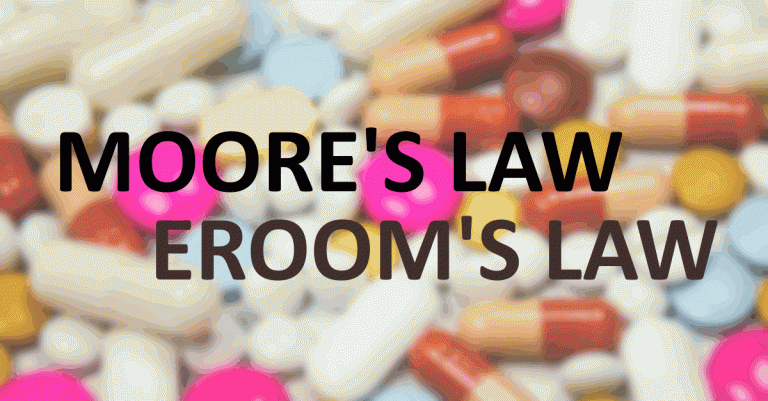Despite the large number of advances in the scientific and technical field underlying the drug discovery process (DNA sequencing, molecular biology, structural biology, HTS, bioinformatics…) as well as the improvements in the management area, the efficiency of the drug discovery R&D has not followed an increasing trend.
This observation has been named by Jack W. Scannell, Alex Blanckley, Helen Boldon & Brian Warrington in the article Diagnosing the decline in pharmaceutical R&D efficiency as Eroom’s law, which is Moore’s law spelt backwards.
Contrary to the well-known Moore’s law, developed by Intel’s co-founder Gordon Moore that observed and predicted that the number of transistors in an integrated circuit would double every two years (with its corresponding increase on performance), Eroom’s law (“Moore” reversed) depicts that the number of new drugs approved per billion US dollars spent on R&D has followed a decreasing trend.
“ Eroom’s law indicates the number of new drugs approved per billion US dollars spent on R&D has halved roughly every nine years since 1950 “
This observation brings to light the continued decrease of the pharmaceutical R&D efficiency.

Image obtained from Diagnosing the decline in pharmaceutical R&D efficiency. It Represents the number of new drugs approved by the FDA per billion dollars (Inflation adjusted) spent on R&D since 1950.
While the number of new drugs that appear in the market is almost steady in time, the R&D expenses have been increasing considerably.
This trend indicates that the cost of discovering and developing a newly approved drug is becoming more and more expensive. The expenses for a newly approved drug will reach unexpected values over the next few years if this trend continues.
However, why is there such a continuous decline of R&D productivity despite the latest advances in the field?
In addition to the complexity of biological systems, Jack W. Scannell and its colleagues describe some of the potential underlying causes of this phenomena in their publication:
- The continue competition against the previously effective approved drugs
- The decrease in the risk tolerance by the regulatory authorities
- The R&D budget and human resources increase strategy
- The reliance on basic research and brute force methods
Pharmaceutical R&D productivity is a hot topic with a deep impact in the industry. Hence, several authors have suggested different strategies to overcome this decreasing trend.
What do you you think is slowing down pharmaceutical R&D productivity? Will the pharmaceutical industry revert the situation and transform Eroom’s law into Moore’s law for drug development? Or should we just get used to a market with declining Returns On Investment? Which measures do you think are necessary to change this trend? Share your opinion with us!
You can find a further detailed analysis and diagnosis of this scenario in the original article or in other related articles.
